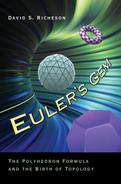APPENDIX B
RECOMMENDED READINGS
There is a complete bibliography at the end of this book. It contains all the sources that I used to prepare this book as well as many of the primary sources for the theorems you read about. I would like to highlight a few of these books and articles for the benefit of those readers who would like to learn more about the topics in this book. I will give the title and author. To find the complete bibliographic information, consult the references.
There are many good reference books for the history of mathematics. The first one I turn to is Carl Boyer and Uta Merzbach’s A History of Mathematics. For biographies I recommend the eighteen-volume Dictionary of Scientific Biography, which can be found in the reference section of the library. It contains high-quality biographies written by experts in the field. For thoroughly entertaining, if not always historically accurate biographies, read Eric Temple Bell’s 1937 classic Men of Mathematics. A very convenient resource is John O’Connor and Edmund Robertson’s online MacTutor History of Mathematics Archive. This searchable Web- site contains numerous biographies as well as other valuable historical information.
There are many good resources on Euler, including a number of new ones that appeared in 2007, “the year of Euler.” I recommend two new edited volumes, The Genius of Euler: Reflections on His Life and Work, edited by William Dunham, and Leonhard Euler: Life, Work and Legacy, edited by Robert Bradley and Edward Sandifer. Euler’s collected works are available in the seventy-six-volume Opera omnia, and most are available online at Dominic Klyve and Lee Stemkoski’s Euler Archive. A complete English translation of Euler’s “Demonstratio nonnullarum insignium proprietatum quibus solida hedris planis inclusa sunt praedita” by Chris Francese and the author is available at the Euler Archive.
For more information on polyhedra, consult Peter Cromwell’s Polyhedra. Many of the topics in this book can be found there. In this wonderful book, Cromwell presents both the history and the theory of polyhedra.
The definitive discussion of the development of Euler’s formula is Imre Lakatos’s Proofs and Refutations: The Logic of Mathematical Discovery. In this classic work, Lakatos, a philosopher of mathematics, uses Euler’s formula and the many proofs, exceptions, and generalizations to present his view of mathematical discovery. The detailed footnotes were extremely useful to me as I researched this book.
To learn more about the history and content of Descartes’ lost manuscript The Elements of Solids, read P. J. Federico’s Descartes on Polyhedra: A Study of the De Solidorum Elementis. In addition to commentary, it contains reproductions of Leibniz’s copies of Descartes’ notes and English translations of them.
For topics in graph theory one cannot do better than the wonderful books and papers of Robin Wilson and his coauthors. For a history of graph theory, see Norman Biggs, Keith Lloyd, and Robin Wilson’s Graph Theory, 1736–1936. It is a well-written resource complete with translations of many important articles. For a myth-busting account of the bridges of Königsberg problem, consult Brian Hopkins and Robin Wilson’s “The Truth about Königsberg.” And for a captivating account of the proof of the four color theorem, pick up Wilson’s Four Colors Suffice: How the Map Problem Was Solved.
There are two excellent references available on the history of topology. One is the mammoth (1,000+ pages) History of Topology edited by I. M. James, and the other is the slightly shorter A History of Algebraic and Differential Topology: 1900–1960 by Jean Dieudonné. These high- level texts were written for professional mathematicians.
Accessible works on the Euler number, combinatorial topology, geometry, and high-dimensional manifolds include D. M. Y. Sommerville’s An Introduction to the Geometry of n Dimensions, David Hilbert and Stephan Cohn-Vossen’s Geometry and the Imagination, Maurice Fréchet and Ky Fan’s Initiation to Combinatorial Topology, and Jeffrey Weeks’s The Shape of Space. For those who read French I recommend Jean-Claude Pont’s La topologie algèbrique des origines à Poincaré.
To those who enjoy building topological surfaces out of paper and would like other activities, I recommend Stephen Barr’s Experiments in Topology. Every mathematics enthusiast should seek out Martin Gardner’s many marvelous books. They are full of fascinating mathematical gems. The Mathematical Association of America recently released fifteen of his books on one CD-ROM called Martin Gardner’s Mathematical Games: The Entire Collection of his Scientific American Columns.
See Martin Aigner and Günter Ziegler’s Proofs from The Book for a few other nice applications of Euler’s formula. They also give an elementary proof of Cauchy’s rigidity theorem for convex polyhedra. For an elegant and visual proof of the classification theorem for surfaces, see “Conway’s ZIP proof” by George Francis and Jeffrey Weeks. Read Edwin Abbott’s 1884 classic Flatland: A Romance of Many Dimensions to get a social satire together with an investigation of the notion of mathematical dimension, all in one novella.
For an introduction to knot theory, read Colin Adams’s The Knot Book: An Elementary Introduction to the Mathematical Theory of Knots. It can be used as a textbook, but it reads like a pop math book.
Sylvia Nasar and David Gruber wrote an article for The New Yorker titled “Manifold Destiny: A Legendary Problem and the Battle Over Who Solved it.” In it they detail the controversy surrounding the proof of the Poincaré conjecture and Thurston’s geometrization conjecture.
Mathematicians voted Euler’s polyhedron formula the second-most beautiful theorem in all of mathematics. We have seen a few other top-10 theorems as well: there are five regular polyhedra (#4), the Brouwer fixed point theorem (#6), ![]() 2 is irrational (#7), and the four color theorem (#9). To see the rest of the list, consult David Wells’s article “Are These the Most Beautiful?”
2 is irrational (#7), and the four color theorem (#9). To see the rest of the list, consult David Wells’s article “Are These the Most Beautiful?”
